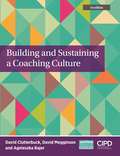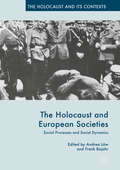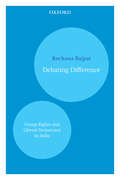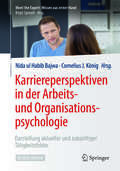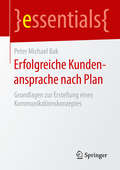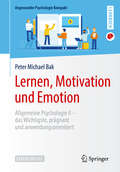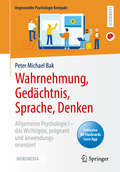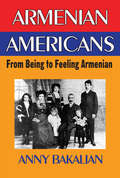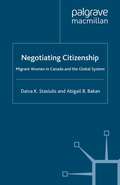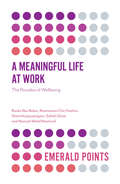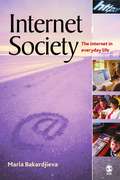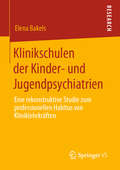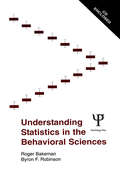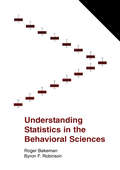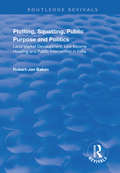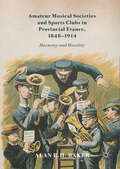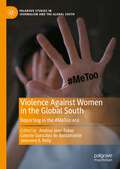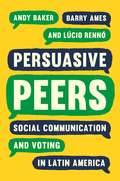- Table View
- List View
Building and Sustaining a Coaching Culture
by Agnieszka Bajer David Clutterbuck David MegginsonBuilding and Sustaining a Coaching Culture is the ideal book for everyone who is passionate about coaching and who has an interest in creating an environment that supports learning and growth. Easy to navigate and logically structured, topics include the current understanding of coaching culture in organisations, coaching and mentoring culture strategy, making effective use of external coaches, formal and informal mentoring, developing and supporting internal coaches and mentors, team coaching, cross-cultural marketing coaching and cross-cultural issues. This edition of Building and Sustaining a Coaching Culture is a fully revised version of the seminal book Making Coaching Work: Creating a Coaching Culture. It analyses what has changed in the field of coaching culture and provides update on new knowledge and experience. A wide variety of international case studies and engaging tools such as chapter overviews, templates, and reflective questions will take you clearly through the development and implementation of a successful and integrated training culture. Whether you are an HR Manager looking to maximise the positive impact of coaching in your organisation, a business leader wanting to facilitate growth, or a consultant or coach seeking to place your work in the relevant organisational context, you will be shown how to implement an effective coaching and mentoring strategy that meets your needs.
Building and Sustaining a Coaching Culture
by Agnieszka Bajer David Clutterbuck David MegginsonBuilding and Sustaining a Coaching Culture is the ideal book for everyone who is passionate about coaching and who has an interest in creating an environment that supports learning and growth. Easy to navigate and logically structured, topics include the current understanding of coaching culture in organisations, coaching and mentoring culture strategy, making effective use of external coaches, formal and informal mentoring, developing and supporting internal coaches and mentors, team coaching, cross-cultural marketing coaching and cross-cultural issues. This edition of Building and Sustaining a Coaching Culture is a fully revised version of the seminal book Making Coaching Work: Creating a Coaching Culture. It analyses what has changed in the field of coaching culture and provides update on new knowledge and experience. A wide variety of international case studies and engaging tools such as chapter overviews, templates, and reflective questions will take you clearly through the development and implementation of a successful and integrated training culture. Whether you are an HR Manager looking to maximise the positive impact of coaching in your organisation, a business leader wanting to facilitate growth, or a consultant or coach seeking to place your work in the relevant organisational context, you will be shown how to implement an effective coaching and mentoring strategy that meets your needs.
The Holocaust and European Societies: Social Processes and Social Dynamics (The Holocaust and its Contexts)
by Frank Bajohr Andrea LöwThis book explores the Holocaust as a social process. Although the mass murder of European Jews was essentially the result of political-ideological decisions made by the Nazi state leadership, the events of the Holocaust were also part of a social dynamic. All European societies experienced developments that led to the social exclusion, persecution and murder of the continent’s Jews. This volume therefore questions Raul Hilberg´s category of the ‘bystander’. In societies where the political order expects citizens to endorse the exclusion of particular groups in the population, there cannot be any completely uninvolved bystanders. Instead, this book examines the multifarious forms of social action and behaviour connected with the Holocaust. It focuses on institutions and persons, helpers, co-perpetrators, facilitators and spectators, beneficiaries and profiteers, as well as Jewish victims and Jewish organisations trying to cope with the dynamics of exclusion and persecution.
Debating Difference: Group Rights and Liberal Democracy in India
by Rochana BajpaiHow can inequalities between groups be addressed, while at the same time sustaining common citizenship? Debating Difference offers a new approach to this key question for liberal democracies, demonstrating that argument and debate is crucial for reconciling the demands of group equality and civic unity. India offers a unique case of group-differentiated rights. Using landmark constitutional and legislative debates on minority rights and quotas, Rochana Bajpai develops a model for interpreting post-Independence group rights that hinges on the interplay between five principal normative concepts—secularism, democracy, social justice, national unity, and development. Tracing the shifting meanings of these values over time, this book demonstrates that liberal and democratic concepts are more sophisticated and widely shared in the Indian polity than is commonly believed. The author identifies the limits of Western-centric accounts of multiculturalism. She also establishes the significance of political rhetoric for explanations of policy shifts and political change.
Karriereperspektiven in der Arbeits- und Organisationspsychologie: Darstellung aktueller und zukünftiger Tätigkeitsfelder (Meet the Expert: Wissen aus erster Hand)
by Nida Ul Bajwa Cornelius J. KönigDieses Buch bietet Studienanfängern sowie Abiturienten, die sich für die Arbeits- und Organisationspsychologie interessieren, Einblicke in die vielfältigen Berufsfelder des Fachgebiets. Die Arbeits- und Organisationspsychologie hat sich in den letzten Jahrzehnten in Deutschland sehr gut etabliert, sowohl innerhalb der Psychologie als auch in der Wirtschaft. Es ist nach der klinischen Psychologie das zweitwichtigste Anwendungsfach der Psychologie. So richten sich über 30% aller ausgeschriebenen Arbeitsstellen für Psychologen an Psychologie-Absolventen mit einem Schwerpunkt in der Arbeits- und Organisationspsychologie. Experten aus der Praxis stellen in diesem Band sehr anschaulich Ihren Berufsalltag dar, schildern ihre persönlichen Werdegänge und zeigen mögliche Karriereperspektiven für angehende Arbeits-, Organisations- und Wirtschaftspsychologen auf. Dadurch gibt dieses Werk eine wertvolle Orientierung und erleichtert den Entscheidungsprozess. Kurze Video-Clips aus den Experteninterviews bereichern den Inhalt durch zusätzlichen Nutzen.
Erfolgreiche Kundenansprache nach Plan: Grundlagen zur Erstellung eines Kommunikationskonzeptes (essentials)
by Peter Michael BakIn diesem essential erläutert Peter Michael Bak, wie ein Kommunikationskonzept für ein Produkt, eine Marke, eine Dienstleistung oder eine Veranstaltung geplant sowie entwickelt wird und dabei die wesentlichen Erfolgskriterien berücksichtigt werden. Werbepsychologische Grundlagen und Praxistipps am Ende der einzelnen Kapitel bieten darüber hinaus nützliche Hilfestellung für die eigene Arbeit. Damit sind die Ausführungen für alle interessant, die im Studium, in der Ausbildung oder bereits in Agenturen oder in Unternehmen mit der Aufgabe betraut sind, eine erfolgreiche Kommunikationsmaßnahme planen und umsetzen zu müssen. Ganz gleich, ob es um (neue) Produkte und Dienstleistungen, Events oder News geht, erst eine sorgfältige Planung von geeigneten Maßnahmen macht den Erfolg möglich.
Gesundheitspsychologie: Eine Einführung – kompakt, prägnant und anwendungsorientiert (Angewandte Psychologie Kompakt)
by Peter Michael BakDieses prägnante Lehrbuch aus der Lehrbuchreihe Angewandte Psychologie Kompakt enthält die wichtigsten psychologischen Theorien und Konzepte rund um das Trendthema Gesundheitspsychologie. Es ist speziell für Studierende konzipiert, die sich einen schnellen und eingängigen Überblick über die Thematik sowie einen starken Praxisbezug wünschen. Die sorgfältige Didaktik, Klausurfragen, digitale Zusatzmaterialien und Zusammenfassungen stellen eine optimale Grundlage für das Verstehen des Lehrstoffes und die Prüfungsvorbereitung im Bereich der Gesundheitspsychologie dar. Durch zahlreiche Anwendungsbeispiele, Reflexionsfragen, eingebundene Audioclips und Online-Zusatzmaterialien ist es in einzigartiger Weise anwendungsorientiert und weckt dadurch Lust, das Gelernte gedanklich weiterzuentwickeln und in verschiedensten Kontexten umzusetzen. Zusätzlich sind Fragen und Antworten zum Selbsttest über die SN Flashcards Lern-App inkludiert. Der Zugangscode befindet sich im gedruckten Buch.
Lernen, Motivation und Emotion: Allgemeine Psychologie II – das Wichtigste, prägnant und anwendungsorientiert (Angewandte Psychologie Kompakt)
by Peter Michael BakDieses prägnante Lehrbuch enthält die wichtigsten psychologischen Theorien und Konzepte aus den Bereichen Lernen, Motivation und Emotion. Es ist speziell für Studierende konzipiert, die sich einen starken Praxisbezug wünschen. Die sorgfältige Didaktik, Klausurfragen, digitale Zusatzmaterialien und Zusammenfassungen stellen eine optimale Grundlage für das Verstehen des Lehrstoffes und die Prüfungsvorbereitung im Bereich der Allgemeinen Psychologie II dar. Durch zahlreiche Anwendungsbeispiele, eingebundene Audioclips und Online-Zusatzmaterialien ist es in einzigartiger Weise anwendungsorientiert und weckt dadurch Lust, das Gelernte gedanklich weiterzuentwickeln und in verschiedensten Kontexten umzusetzen.
Wahrnehmung, Gedächtnis, Sprache, Denken: Allgemeine Psychologie I – das Wichtigste, prägnant und anwendungsorientiert (Angewandte Psychologie Kompakt)
by Peter Michael BakDieses prägnante Lehrbuch enthält die wichtigsten psychologischen Theorien und Konzepte aus den Bereichen Wahrnehmung, Aufmerksamkeit, Gedächtnis, Sprache und Denken. Es ist speziell für Studierende konzipiert, die sich einen starken Praxisbezug wünschen. Die sorgfältige Didaktik, Klausurfragen, digitale Zusatzmaterialien und Zusammenfassungen stellen eine optimale Grundlage für das Verstehen des Lehrstoffes und die Prüfungsvorbereitung im Bereich der Allgemeinen Psychologie I dar. Durch zahlreiche Anwendungsbeispiele, eingebundene Audioclips und Online-Zusatzmaterialien ist es in einzigartiger Weise anwendungsorientiert und weckt dadurch Lust, das Gelernte gedanklich weiterzuentwickeln und in verschiedensten Kontexten umzusetzen. Zusätzlich sind Fragen und Antworten zum Selbsttest über die SN Flashcards Lern-App inkludiert. Der Zugangscode befindet sich im gedruckten Buch.
Armenian-Americans: From Being to Feeling American
by Anny BakalianAssimilation has been a contentious issues for most immigrant groups in the United States. The host society is assumed to lire immigrants and their descendants away from their ancestral heritage. Yet, in their quest for a "better" life, few immigrants intentionally forsake heir ethnic identity; most try to hold onto their culture by transplanting their traditional institutions and recreating new communities in America. Armenian-Americans are no exception. Armenian-Americans have been generally overlooked by census enumerators, survey analysts, and social scientists because of their small numbers and relative dispersion throughout the United States. They remain a little-studied group that has been called a "hidden minority." Armenian Americans fills this significant gap. Based on the results of an extensive mail questionnaire survey, in-depth interviews, and participant observation of communal gatherings, this book analyzed the individual and collective struggles of Armenian-Americans to perpetuate their Armenian legacy while actively seeking new pathways to the American Dream. This volume shows how men and women of Armenian descent become distanced from their ethnic origins with the passing of generations. Yet assimilation and maintenance of ethnic identity go hand-in-hand. The ascribed, unconscious, compulsive Armenianness of the immigrant generation is transformed into a voluntary, rational, situational Armenianness. The generational change is from being Armenian to feeling Armenian. The Armenian-American community has grown and prospered in this century. Greater tolerance of ethnic differences in the host society, the remarkable social mobility of many Armenian-Americans and the influx of large numbers of new immigrants from the Middle East and Soviet bloc in recent decades have contributed to this development. The future of this community, however, remains precarious as it strives to adjust to the ever changing social, economic, and political conditions affec
Armenian-Americans: From Being to Feeling American
by Anny BakalianAssimilation has been a contentious issues for most immigrant groups in the United States. The host society is assumed to lire immigrants and their descendants away from their ancestral heritage. Yet, in their quest for a "better" life, few immigrants intentionally forsake heir ethnic identity; most try to hold onto their culture by transplanting their traditional institutions and recreating new communities in America. Armenian-Americans are no exception. Armenian-Americans have been generally overlooked by census enumerators, survey analysts, and social scientists because of their small numbers and relative dispersion throughout the United States. They remain a little-studied group that has been called a "hidden minority." Armenian Americans fills this significant gap. Based on the results of an extensive mail questionnaire survey, in-depth interviews, and participant observation of communal gatherings, this book analyzed the individual and collective struggles of Armenian-Americans to perpetuate their Armenian legacy while actively seeking new pathways to the American Dream. This volume shows how men and women of Armenian descent become distanced from their ethnic origins with the passing of generations. Yet assimilation and maintenance of ethnic identity go hand-in-hand. The ascribed, unconscious, compulsive Armenianness of the immigrant generation is transformed into a voluntary, rational, situational Armenianness. The generational change is from being Armenian to feeling Armenian. The Armenian-American community has grown and prospered in this century. Greater tolerance of ethnic differences in the host society, the remarkable social mobility of many Armenian-Americans and the influx of large numbers of new immigrants from the Middle East and Soviet bloc in recent decades have contributed to this development. The future of this community, however, remains precarious as it strives to adjust to the ever changing social, economic, and political conditions affec
Negotiating Citizenship: Migrant Women in Canada and the Global System
by A. Bakan D. StasiulisNegotiating Citizenship explores the growing inequalities associated with nation-based citizenship from the perspective of migrant women workers who have made their way from impoverished Third World countries to work in Canada in the caregiving industries of domestic service and nursing. The study demonstrates the impact of the global political economy, public and private gatekeeping mechanisms, and racialized and gendered stereotypes on the contested relationship between citizen-employers and non-citizen female migrant workers in Canada.
A Meaningful Life at Work: The Paradox of Wellbeing (Emerald Points)
by Raida Abu Bakar Rosmawani Che Hashim Sharmila Jayasingam Safiah Omar Norizah Mohd MustamilA Meaningful Life at Work addresses a range of contemporary issues that impact on an individual's experiences in the workplace, including those that may restrict opportunities for personal growth in a professional setting. Understanding an employee's values, their choices and the problems they face in the workplace may help organisations to better structure their human resource policies, compensation packages and working conditions. The authors explore employee wellbeing from a Malaysian perspective as a developing country, but they also reflect on the broader Asian and wider global context. The key themes analysed in this book include work addiction, cyber bullying, sexual harassment in the workplace and the ethics of workplace behaviour. The book contributes to the theoretical discourse around organisation studies and employee wellbeing, while also seeking to integrate academic concepts with practice. In this way, it offers practical steps towards promoting positivity and happiness in the workplace.
A Meaningful Life at Work: The Paradox of Wellbeing (Emerald Points)
by Raida Abu Bakar Rosmawani Che Hashim Sharmila Jayasingam Safiah Omar Norizah Mohd MustamilA Meaningful Life at Work addresses a range of contemporary issues that impact on an individual's experiences in the workplace, including those that may restrict opportunities for personal growth in a professional setting. Understanding an employee's values, their choices and the problems they face in the workplace may help organisations to better structure their human resource policies, compensation packages and working conditions. The authors explore employee wellbeing from a Malaysian perspective as a developing country, but they also reflect on the broader Asian and wider global context. The key themes analysed in this book include work addiction, cyber bullying, sexual harassment in the workplace and the ethics of workplace behaviour. The book contributes to the theoretical discourse around organisation studies and employee wellbeing, while also seeking to integrate academic concepts with practice. In this way, it offers practical steps towards promoting positivity and happiness in the workplace.
Internet Society: The Internet in Everyday Life (PDF)
by Maria Bakardjieva`A highly topical, interesting and lively analysis of ordinary internet use, based on both theoretically competent reflections and sound ethnographic material' - Joost van Loon, Reader in Social Theory at Nottingham Trent University Internet Society investigates internet use and it's implications for society through insights into the daily experiences of ordinary users. Drawing on an original study of non-professional, 'ordinary' users at home, this book examines how people interpret, domesticate and creatively appropriate the Internet by integrating it into the projects and activities of their everyday lives. Maria Bakardjieva's theoretical framework uniquely combines concepts from several schools of thought (social constructivism, critical theory, phenomenological sociology) to provide a conception of the user as an agent in the field of technological development and new media shaping. She: - examines the evolution of the Internet into a mass medium - interrogates what users make of this new communication medium - evaluates the social and cultural role of the Internet by looking at the immediate level of users' engagement with it - exposes the dual life of technology as invader and captive; colonizer and colonized This book will appeal to academics and researchers in social studies of technology, communication and media studies, cultural studies, philosophy of technology and ethnography.
Klinikschulen der Kinder- und Jugendpsychiatrien: Eine rekonstruktive Studie zum professionellen Habitus von Kliniklehrkräften
by Elena BakelsKlinikschulen der Kinder- und Jugendpsychiatrien führen ein Schattendasein in der bildungs- und erziehungswissenschaftlichen Forschung. In dieser Studie wird dieses Desiderat aufgegriffen und danach gefragt, welche Herausforderungen sich in der schulischen Arbeit mit psychisch erkrankten Schülerinnen und Schülern in Kinder- und Jugendpsychiatrien ergeben. Welche professionellen Habitus der Kliniklehrkräfte lassen sich identifizieren? Auf Grundlage von Analysen mit der Dokumentarischen Methode zeigt die Autorin, wie Kliniklehrkräfte mit der dem Arbeitsfeld inhärenten Spannung zwischen Pädagogik und Therapie umgehen.
Understanding Statistics in the Behavioral Sciences
by Roger Bakeman Byron F. RobinsonUnderstanding Statistics in the Behavioral Sciences is designed to help readers understand research reports, analyze data, and familiarize themselves with the conceptual underpinnings of statistical analyses used in behavioral science literature. The authors review statistics in a way that is intended to reduce anxiety for students who feel intimidated by statistics. Conceptual underpinnings and practical applications are stressed, whereas algebraic derivations and complex formulas are reduced. New ideas are presented in the context of a few recurring examples, which allows readers to focus more on the new statistical concepts than on the details of different studies.The authors' selection and organization of topics is slightly different from the ordinary introductory textbook. It is motivated by the needs of a behavioral science student, or someone in clinical practice, rather than by formal, mathematical properties. The book begins with hypothesis testing and then considers how hypothesis testing is used in conjunction with statistical designs and tests to answer research questions. In addition, this book treats analysis of variance as another application of multiple regression. With this integrated, unified approach, students simultaneously learn about multiple regression and how to analyze data associated with basic analysis of variance and covariance designs. Students confront fewer topics but those they do encounter possess considerable more power, generality, and practical importance. This integrated approach helps to simplify topics that often cause confusion.Understanding Statistics in the Behavioral Sciences features:*Computer-based exercises, many of which rely on spreadsheets, help the reader perform statistical analyses and compare and verify the results using either SPSS or SAS. These exercises also provide an opportunity to explore definitional formulas by altering raw data or terms within a formula and immediately see the consequences thus providing a deeper understanding of the basic concepts.*Key terms and symbols are boxed when first introduced and repeated in a glossary to make them easier to find at review time.*Numerous tables and graphs, including spreadsheet printouts and figures, help students visualize the most critical concepts.This book is intended as a text for introductory behavioral science statistics. It will appeal to instructors who want a relatively brief text. The book's active approach to learning, works well both in the classroom and for individual self-study.
Understanding Statistics in the Behavioral Sciences
by Roger Bakeman Byron F. RobinsonUnderstanding Statistics in the Behavioral Sciences is designed to help readers understand research reports, analyze data, and familiarize themselves with the conceptual underpinnings of statistical analyses used in behavioral science literature. The authors review statistics in a way that is intended to reduce anxiety for students who feel intimidated by statistics. Conceptual underpinnings and practical applications are stressed, whereas algebraic derivations and complex formulas are reduced. New ideas are presented in the context of a few recurring examples, which allows readers to focus more on the new statistical concepts than on the details of different studies.The authors' selection and organization of topics is slightly different from the ordinary introductory textbook. It is motivated by the needs of a behavioral science student, or someone in clinical practice, rather than by formal, mathematical properties. The book begins with hypothesis testing and then considers how hypothesis testing is used in conjunction with statistical designs and tests to answer research questions. In addition, this book treats analysis of variance as another application of multiple regression. With this integrated, unified approach, students simultaneously learn about multiple regression and how to analyze data associated with basic analysis of variance and covariance designs. Students confront fewer topics but those they do encounter possess considerable more power, generality, and practical importance. This integrated approach helps to simplify topics that often cause confusion.Understanding Statistics in the Behavioral Sciences features:*Computer-based exercises, many of which rely on spreadsheets, help the reader perform statistical analyses and compare and verify the results using either SPSS or SAS. These exercises also provide an opportunity to explore definitional formulas by altering raw data or terms within a formula and immediately see the consequences thus providing a deeper understanding of the basic concepts.*Key terms and symbols are boxed when first introduced and repeated in a glossary to make them easier to find at review time.*Numerous tables and graphs, including spreadsheet printouts and figures, help students visualize the most critical concepts.This book is intended as a text for introductory behavioral science statistics. It will appeal to instructors who want a relatively brief text. The book's active approach to learning, works well both in the classroom and for individual self-study.
Plotting, Squatting, Public Purpose and Politics: Land Market Development, Low Income Housing and Public Intervention in India
by Robert Jan BakenThis title was first published in 2003. Since independence in 1947, India has undergone a phase of rapid urbanization. New planning laws have been passed, new organizations established, public policy documents and discussion papers prepared and a host of land and housing schemes have been implemented. Still, however, the vast majority of urban expansion is an unplanned process that takes the form of squatting and illegal or semi-legal land subdivision. By looking in detail at two rapidly growing cities in Andhra Pradesh (Vijayawada and Viaskhapatnam) this book explores cultural, physical-spatial, political and economic determinants of the allocation of urban land and of urban growth in India in historical context. It focuses on the interplay between the government and the organizations in charge of their implementation, and the private sector on the other. Special attention is given to the conditions of the urban poor, with the changes in their socio-economic conditions.
Plotting, Squatting, Public Purpose and Politics: Land Market Development, Low Income Housing and Public Intervention in India
by Robert Jan BakenThis title was first published in 2003. Since independence in 1947, India has undergone a phase of rapid urbanization. New planning laws have been passed, new organizations established, public policy documents and discussion papers prepared and a host of land and housing schemes have been implemented. Still, however, the vast majority of urban expansion is an unplanned process that takes the form of squatting and illegal or semi-legal land subdivision. By looking in detail at two rapidly growing cities in Andhra Pradesh (Vijayawada and Viaskhapatnam) this book explores cultural, physical-spatial, political and economic determinants of the allocation of urban land and of urban growth in India in historical context. It focuses on the interplay between the government and the organizations in charge of their implementation, and the private sector on the other. Special attention is given to the conditions of the urban poor, with the changes in their socio-economic conditions.
Extremists in Our Midst: Confronting Terror (New Security Challenges)
by Abdul Haqq BakerBaker provides a unique insider perspective on factors affecting British Muslim converts and their susceptibility to violent radicalisation, including firsthand accounts of convicted terrorists Richard Reid (the 'Shoe Bomber'), Zacarius Moussaoui (the 20th 9/11 bomber), and Abdullah el-Faisal who is alleged to have been a radicalising influence.
Amateur Musical Societies and Sports Clubs in Provincial France, 1848-1914: Harmony and Hostility
by Alan R. BakerThis book explores leisure-related voluntary associations in France during the nineteenth century as practical expressions of the Revolutionary concept of fraternité. Using a mass of unpublished sources in provincial and national archives, it analyses the history, geography and cultural significance of amateur musical societies and sports clubs in eleven départements of France between 1848 and 1914. It demonstrates that, although these voluntary associations drew upon and extended the traditional concept of cooperation and community, and the Revolutionary concept of fraternity, they also incorporated the fundamental characteristics of competition and conflict. Although intended to produce social harmony, in practice they reflected the ideological hostilities and cultural tensions that permeated French society in the nineteenth century.
Violence Against Women in the Global South: Reporting in the #MeToo era (Palgrave Studies in Journalism and the Global South)
by Andrea Jean Baker Celeste González de Bustamante Jeannine E. RellyBringing together 14 journalism scholars from around the world, this edited collection addresses the deficit of coverage of violence against women in the Global South by examining the role of the legacy press and social media that report on and highlight ways to improve reporting. Authors investigate the ontological limitations which present structural and systemic challenges for journalists who report on the normalization of violence against women in country cases in Argentina; Brazil; Mexico; Indonesia; Kenya, Nigeria, South Africa; Egypt; Libya, Syria, and Yemen. Challenges include patriarchal forces; gender imbalance in newsrooms; propaganda and censorship strategies by repressive, hyper-masculine, and populist political regimes; economic and digital inequities; and civil and transnational wars. Presenting diverse conceptual, methodological, and empirical chapters, the collection offers a revision of existing frameworks and guidelines and aims to promote more gender-sensitive, trauma-informed, solutions-driven, and victim or survivor centered reporting in the region.
Persuasive Peers: Social Communication and Voting in Latin America (Princeton Studies in Global and Comparative Sociology)
by Andy Baker Barry Ames Lúcio RennóHow voting behavior in Latin America is influenced by social networks and everyday communication among peersIn Latin America’s new democracies, political parties and mass partisanship are not deeply entrenched, leaving many votes up for grabs during election campaigns. In a typical presidential election season, between one-quarter and one-half of all voters—figures unheard of in older democracies—change their voting intentions across party lines in the months before election day. Advancing a new theory of Latin American voting behavior, Persuasive Peers argues that political discussions within informal social networks among family members, friends, neighbors, coworkers, and acquaintances explain this volatility and exert a major influence on final voting choices.Relying on unique survey and interview data from Latin America, the authors show that weakly committed voters defer to their politically knowledgeable peers, creating vast amounts of preference change as political campaigns unfold. Peer influences also matter for unwavering voters, who tend to have social contacts that reinforce their voting intentions. Social influence increases political conformity among voters within neighborhoods, states, and even entire regions, and the authors illustrate how party machines use the social topography of electorates to buy off well-connected voters who can magnify the impact of the payoff.Persuasive Peers demonstrates how everyday communication shapes political outcomes in Latin America’s less-institutionalized democracies.
Persuasive Peers: Social Communication and Voting in Latin America (Princeton Studies in Global and Comparative Sociology)
by Andy Baker Barry Ames Lúcio RennóHow voting behavior in Latin America is influenced by social networks and everyday communication among peersIn Latin America’s new democracies, political parties and mass partisanship are not deeply entrenched, leaving many votes up for grabs during election campaigns. In a typical presidential election season, between one-quarter and one-half of all voters—figures unheard of in older democracies—change their voting intentions across party lines in the months before election day. Advancing a new theory of Latin American voting behavior, Persuasive Peers argues that political discussions within informal social networks among family members, friends, neighbors, coworkers, and acquaintances explain this volatility and exert a major influence on final voting choices.Relying on unique survey and interview data from Latin America, the authors show that weakly committed voters defer to their politically knowledgeable peers, creating vast amounts of preference change as political campaigns unfold. Peer influences also matter for unwavering voters, who tend to have social contacts that reinforce their voting intentions. Social influence increases political conformity among voters within neighborhoods, states, and even entire regions, and the authors illustrate how party machines use the social topography of electorates to buy off well-connected voters who can magnify the impact of the payoff.Persuasive Peers demonstrates how everyday communication shapes political outcomes in Latin America’s less-institutionalized democracies.
